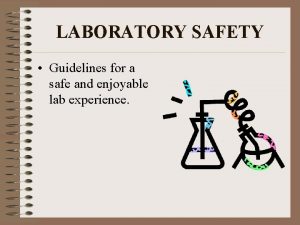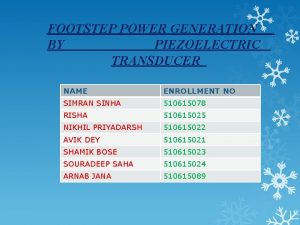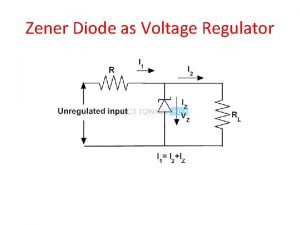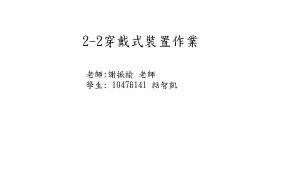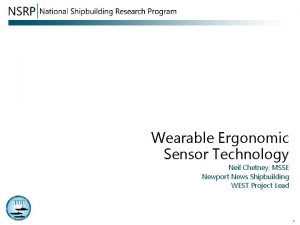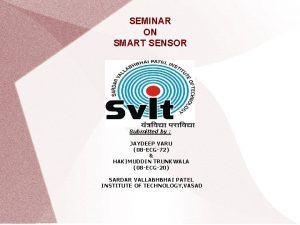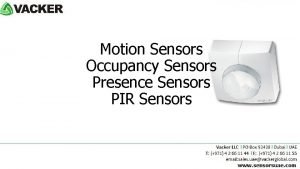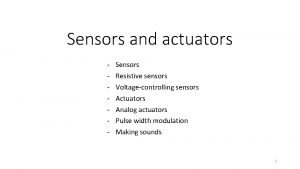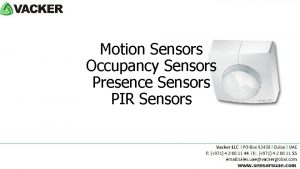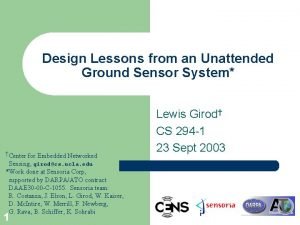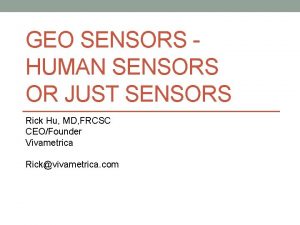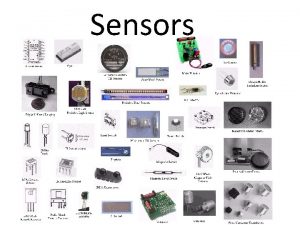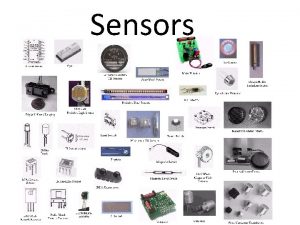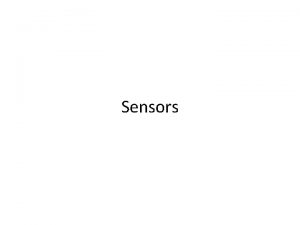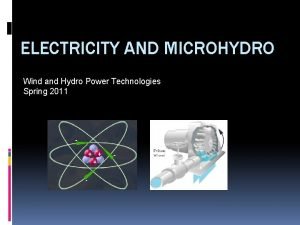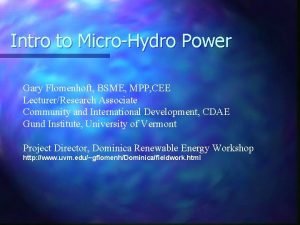MicroHydro Power Generation for Unattended Ground Sensors May





















- Slides: 21

Micro-Hydro Power Generation for Unattended Ground Sensors May 5, 2005 Joint Service Power Expo Richard Mc. Call 2904 44 th Ave N. St. Petersburg, Fl 33714

Unattended Ground Sensors for Jungle and Coastal Environments Narco-terrorists, gun smugglers, and other insurgents use jungle, riverine and coastal supply routes without much fear of interdiction Unattended Ground Sensors (UGS) are being developed for various missions, threats, terrain Sensor systems for anti-terrorism and riverine drug interdiction in jungle terrain pose unique power challenges

Unattended Ground Sensors for Jungle and Coastal Environments Even the lowest power unattended sensors don’t last more than 3 to 14 days In riverine transit routes, it’s difficult to deploy long lasting sensors, and a stealthy, quiet, rechargeable capability is needed Local submersible power generation capability is needed to recharge batteries and extend sensor lifetime

Why Micro-Hydro Power ? Need a simple, concealable recharging power source to achieve 30 to 180 days of unattended operation Conventional gasoline generators are heavy, noisy Solar power works in daytime only; is affected by weather and seasons, shaded by rain forest; is difficult to deploy Fuel cells carry limited fuel, and additional fuel is bulky and heavy; impractical or lack maturity for jungle environment today

The Case for Micro-Hydro Power Wind and other power alternatives are difficult to conceal Security Issue – submerged Micro-hydro power is essentially invisible Seawater is 832 times as dense as air, so 5 knot current has as much kinetic energy as wind velocity of 168 mph. So abundant energy is available

Problem Analysis Assume power requirement: 12 VDC @ 1 to 2 amps 12 to 24 watts for charging batteries Kinetic energy in a two-knot column of water moving past a 12 inch propeller : ½ m V 2 = 41 watts Betz’ Law: The maximum energy that can be extracted from this volume of water => 59 % or 24. 5 watts A commercial underwater generator with a 12 inch propeller measures 9. 6 watts at 2 knots

Commercially Available Generators Most available, small, waterproof generators are designed for use on sailboats No generators are available with impellers designed for very slow flow rates None produce significant power below 2 knots Conclusion: Must increase river current to 2 knots without use of a dam or falling water A “Zero Hydrostatic Head” system is required. Try a venturi to increase flow rate

Equipment Fan Generator Concept

Venturi Transformer Analogy High Voltage Low Current I 1 Low Voltage High Current V 2 I 2 V 1 RL P = I 1 V 1 P = I 2 V 2

Bernoulli’s Equation

Venturi Generator Concept Diagram

CME’s Design for Man-portable Micro-Hydro Generator • Venturi of lightweight, flexible material that automatically expands when de-packaged • May be low-profile to produce power in shallow river environments – inlet doesn’t have to be round • Flaps staked to the bottom using lightweight extendible poles, and weighted with river rocks • Wire inlet guard to protect generator from debris • Patented shape to improve impeller efficiency

Rectify Alternator Output to DC

Micro-Hydro Generator Prototype

Prototype Field Testing Rainbow River

Prototype Field Testing Ft. Desoto

Prototype Field Testing Ft. Desoto

Prototype Field Testing Ft. Desoto

Prototype Micro-Hydro Generator Experimental Results Continuous power was produced with a current of only 1. 4 knots. Generator without venturi stalls below 1. 6 knots. Venturi concept works. Measured 6 VDC at 429 m. A, into a 14 load, for a total of 2. 57 watts. Prototype venturi dimensions are too small for river currents less than one knot. Venturi efficiency is considerably lower than anticipated

Conclusions Venturi generator concept is promising Investigate ways to improve efficiency Smoother surfaces and more streamlined transition Investigate effect of using an outlet bell Add flotation to heavy end of venturi until neutrally buoyant. Inlet must be normal to flow CME is evaluating several custom generator concept designs to better handle low current flow rates

Contact Information Richard E. Mc. Call Custom Manufacturing & Engineering, Inc. 2904 44 th Avenue North St. Petersburg, FL 33714 727 -548 -0522 x 1899 RMc. Call@Custom-Mfg-Eng. com www. custom-mfg-eng. com/
 Unattended software
Unattended software When is a powered industrial truck considered unattended
When is a powered industrial truck considered unattended Never leave a lit burner unattended
Never leave a lit burner unattended What is death
What is death Chemistry lab rules
Chemistry lab rules Unattended stimuli
Unattended stimuli First generation antipsychotics vs second
First generation antipsychotics vs second Lord you are good and your mercy is forever
Lord you are good and your mercy is forever Real power and reactive power
Real power and reactive power What conducts power and ground to the driver's side airbag?
What conducts power and ground to the driver's side airbag? What conducts power and ground to the driver's side airbag?
What conducts power and ground to the driver's side airbag? Disadvantages of foot step power generation
Disadvantages of foot step power generation Power generation forging
Power generation forging What is the working fluid in closed cycle mhd system?
What is the working fluid in closed cycle mhd system? Zener diode equations
Zener diode equations Wearable inertial sensors
Wearable inertial sensors Ergonomic sensors
Ergonomic sensors Smart toilet management system
Smart toilet management system Conclusion of smart sensors
Conclusion of smart sensors Qdm
Qdm Sensors vs intuitives
Sensors vs intuitives Relational agent in ai
Relational agent in ai


